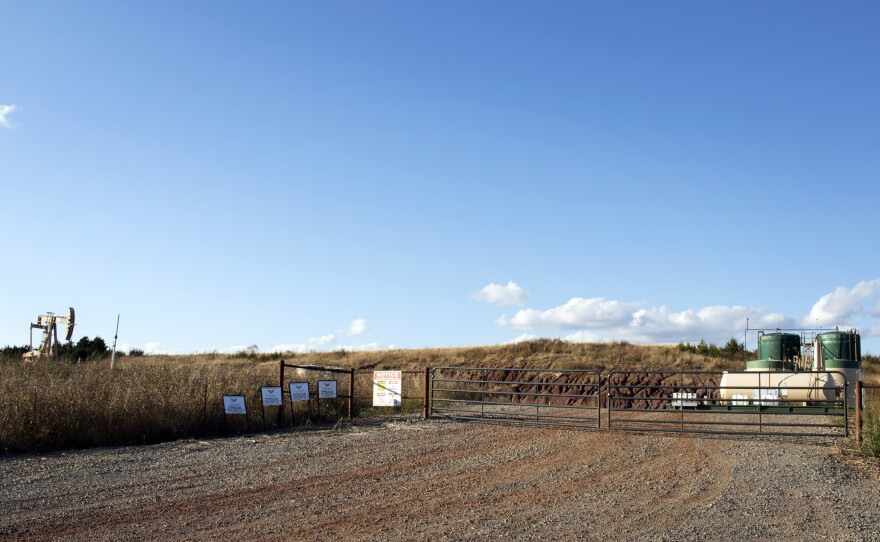
The ground is shaking near Cushing, Okla., home to the largest commercial crude oil storage center in North America. Researchers say the earthquakes could compromise the economically vital energy hub.
Oklahoma is on track to have a record year of earthquakes — more than 5,000 have already been recorded. And those quakes appear to endanger the very industry that created them.
The little patch of prairie in northwestern Oklahoma is one of the most important places in the U.S. energy market.
"We're in amongst about 18 tanks here. Anywhere from 350,000 barrels to 575,000 barrels," Mike Moeller, senior director of mid-continent assets for Enbridge Energy, says.
He walks through the tank farm and worries about all the industry-linked earthquakes. These tanks were built to national standards that account for some shaking, but they weren't constructed with serious earthquakes in mind.
That's because, historically, Oklahoma never had many. That's changed. Last year was record-breaking, and this year, there will likely be even more.
In October, a 4.5-magnitude earthquake struck a few miles away. Moeller says it triggered inspections, but no immediate problems, at the Enbridge tank farm.
"We've not experienced any issues, any deformations or releases that were caused because of an earthquake," Moeller says.
The massive hub in Cushing, where domestic crude oil enters the energy market, is dotted with hundreds of airplane hangar-sized tanks that hold an estimated 54 million barrels of oil.
No earthquake damage has been reported — yet. But the possibility is a matter of national security.
"I have had conversations with Homeland Security. They're concerned about the tanks mostly," says Daniel McNamara, a U.S. Geological Survey Research geophysicist.
He says the faults underneath the oil hub could be primed for more severe shaking.
McNamara's research centers on a series of earthquakes recorded last year. Those quakes and the faults that produced them are strikingly similar to the ones that created the largest quake ever recorded in Oklahoma.
"In fact, it's all part of the same general fault system," McNamara says.
That 5.6-magnitude quake occurred in 2011 near an Oklahoma town called Prague. The two places have something in common: wastewater injection.
Oil and gas production creates a lot toxic wastewater. To keep it from contaminating drinking water, oil companies inject the fluid into underground disposal wells. That can put pressure on faults, causing them to slip.
Scientists say this is exactly what is responsible for Oklahoma's massive earthquake spike. Officials worry that if a strong quake hits Cushing, it would damage the oil hub and disrupt the U.S. energy market.
Back in Cushing, Moeller opens the door to Enbridge Energy's control center where employees monitor the situation.
"One might describe this as 'The Fishbowl,'" he says.
It's like tank farm Mission Control. Two men sit behind banks of screens that flash sensor readouts and pipeline data. When an earthquake strikes, they can dispatch inspectors or flip a switch to move oil out of a leaky tank.
"They go to the USGS site, look at the maps, look at the guidance that's given there, the data that's recorded," Moeller says.
Control center operators ordered inspections after the strong quake last month. In response, state regulators shut down and limited injection at nearby disposal wells.
McNamara, the USGS scientist, says that was smart. They did the same thing last year, too, which he says seemed to slow the shaking — at least for a while.
The earthquake activity near the oil hub resumed when the wells came back online.
Copyright 2015 NPR. To see more, visit http://www.npr.org/.






